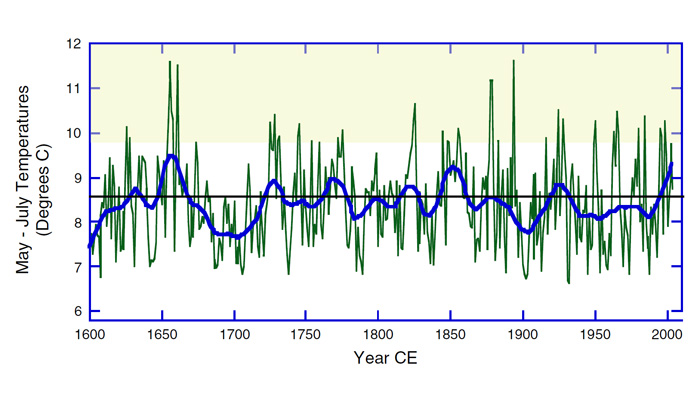| Tweet | Follow @co2science |
Paper Reviewed
Wiles, G.C., Solomina, O., D'Arrigo, R., Anchukaitis, K.J., Gensiarovsky, Y.V. and Wiesenberg, N. 2015. Reconstructed summer temperatures over the last 400 years based on larch ring widths: Sakhalin Island, Russian Far East. Climate Dynamics 45: 397-405.
Introducing the rationale for their study, Wiles et al. (2015) write there exists "a growing number of tree-ring based climate reconstructions from coastal areas in the northwestern Pacific," citing the studies of Gostev et al. (1996), Davi et al. (2002), Jacoby et al. (2004), Solomina et al. (2006) and Barr and Solomina (2013). However, they add that "despite this progress there are no tree-ring reconstructions from true coastal sites bordering the Sea of Okhotsk itself," which void they thus set out to fill by presenting the first such reconstruction from Sakhalin Island in the Russian Far East.
To accomplish their objective, the team of six researchers derived a dendroclimatic reconstruction of temperature based on ring-widths obtained from larch trees (Larix gmelinii var. gmelinii) located on the eastern flank of the Eastern Sakhalin Range in the northern sector of the island (51.03°N, 143.59°E). These ring-widths were found to significantly correlate with May-July average temperatures and thus provided a proxy for those months back in time for the past 400 years. And what information did Wiles et al. glean from their new proxy?
As illustrated in the figure below, decadal variability is a persistent feature throughout the record. The most striking example of such is the strong cooling that occurred between 1680 and 1710 CE, which the authors note is "coincident with the Maunder solar minimum and in agreement with other independent tree-ring reconstructions and glacier histories from sites along the margin of the Sea of Okhotsk." Additionally, the smoothed record shown in blue reveals that although recent decades were indeed fairly warm, they are rivaled by similar periods of warmth centered on 1650-which was of greater magnitude-and 1850 CE-which was about the same level of warmth. What is more, the yearly May-July reconstructed values demonstrate several more episodes of warmer-than-present temperatures, as illustrated by the multiple excursions of the thin green line into the yellow shaded area of the graph.

Reconstructed May-July temperatures for Sakhalin Island derived from larch tree rings from the Chamga Pass. Yellow shading encapsulates years where temperatures exceeded the value derived at the end of the record.
Based on these several findings, Wiles et al. conclude that the recent warmth on Sakhalin Island "is not unprecedented when considered in the context of the last several centuries." Nor is it related to the modern rise in atmospheric CO2. Instead, they say "it is consistent with the declining Siberian High and sea ice both which influence warming in the region." Thus, we have yet another example refuting the climate alarmist claim that temperatures of the past few decades are exceptional or unprecedented over the past thousand years or more.
References
Barr, I.D. and Solomina, O. 2013. Pleistocene and Holocene glacier fluctuations upon the Kamchatka Peninsula. Global and Planetary Change 113: 110-120.
Davi, N., D'Arrigo, R., Jacoby, G., Buckley, B. and Kobayashi, O. 2002. Warm-season annual temperature variability for Hokkaido, Japan reconstructed from tree-ring density data: AD 1557-1990. Climatic Change 52: 201-217.
Gostev, M., Wiles, G.C., D'Arrigo, R.D. and Jacoby, G.C. 1996. Early summer temperatures reconstructed since 1670 A.D. for central Kamchatka based on Siberian Larch tree-ring width data. Canadian Journal of Forest Research 26: 2048-2052.
Jacoby, G., Solomina, O., Frank, D., Eremenko, N. and D'Arrigo, R. 2004. Kunashir (Kurile Islands) oak response to temperature and relation to the Pacific Decadal Oscillation (PDO). Palaeogeography, Palaeoclimatology, Palaeoecology 209: 303-311.
Solomina, O., Wiles, G.C., Shiraiwa, T. and D'Arrigo, R. 2006. Multiproxy records of climate variability for Kamchatka for the past 400 years. Climate of the Past 2: 1051-1073.
Posted 22 September 2015



